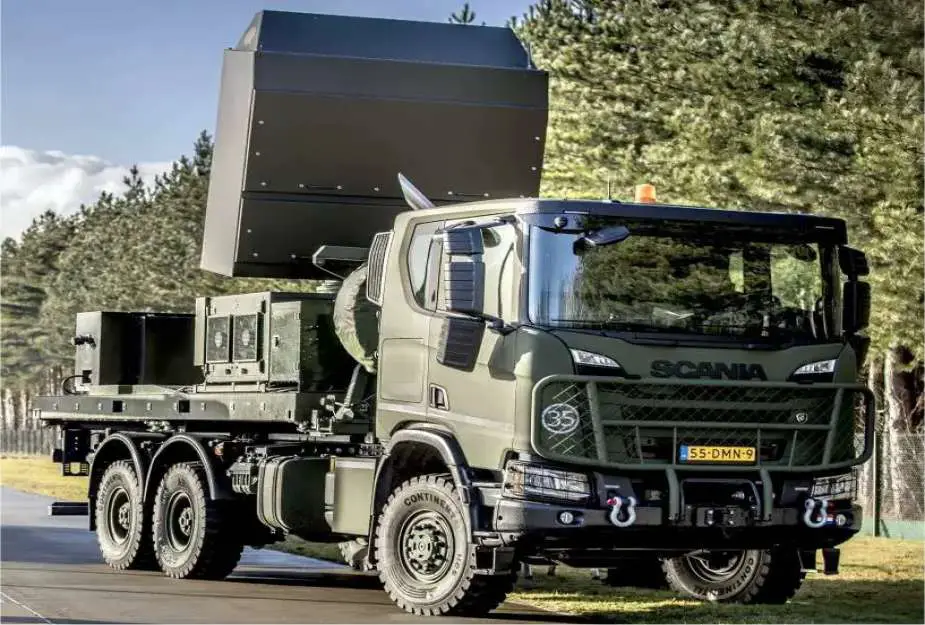On August 24, an interdepartmental meeting was held in Bulgaria to discuss the acquisition of 7 new 3D radars for modernizing the country's armed forces and improving airspace surveillance. The meeting was chaired by Deputy Minister of Defense Stanimir Georgiev and Colonel Dimitar Georgiev. Five leading defense companies—Lockheed Martin, Leonardo, Elta, Indra, and Thales—presented their radar proposals.
Follow Army Recognition on Google News at this link

GM 200 MMC radar on Scania 6x6 chassis (Picture source: Thales)
The interdepartmental working group includes representatives from the Air Force, as well as from the ministries of Defense, Transport, Innovation and Growth, and Economy and Industry. The commission sent out letters to eight companies, three of which did not submit proposals. During the meeting, five defense companies presented their proposals. The competing companies are Lockheed Martin from the United States, Leonardo from Italy, Elta from Israel, Indra from Spain, and Thales from France. Each company submitted a proposal based on the tender sent out by the Bulgarian side.
The project involves the purchase of seven new 3D radars, staff training, a minimum of 24 months of warranty support, and integrated logistical support for the next five years. The estimated cost of the project is around 221 million USD. After evaluating the proposals, negotiations will be initiated with the selected company to finalize the contract.
Five international defense companies have submitted their proposals, showcasing their expertise and technological solutions. Among the competitors are Lockheed Martin from the United States, Leonardo from Italy, Elta from Israel, Indra from Spain, and Thales from France. Each of these companies is a major player in the field of radar technology and defense, offering diverse options in terms of cost, operational capabilities, and maintenance. The final selection will be based on multiple criteria, including acquisition and maintenance costs, industrial cooperation, and service guarantees.
In terms of the radar systems themselves, Lockheed Martin's AN/TPS-77 radar is designed for long-range and low-altitude surveillance, with a detection range of up to 250 miles. It has been delivered to countries like Latvia, Romania, and Taiwan. Leonardo's RAT-31DL radar has an impressive detection range of up to 500 km and can track up to 1,000 targets simultaneously. This radar has been delivered to Italy, Turkey, and Germany among others.
Israel's Elta offers the ELM-2084 MMR radar with a detection range of up to 470 km and the ability to track aerial, terrestrial, and maritime targets. It has been delivered to countries like Israel, India, and Canada. Spain's Indra provides the LANZA 3D radar, designed for long-range air surveillance with a detection range of up to 400 km. It has mainly been delivered to Spain and some NATO countries.
France's Thales offers the Ground Master 200, a multi-mission radar with a detection range of up to 250 km in surveillance mode and 100 km in engagement mode. It has been delivered to countries like France, Finland, and Estonia.
In summary, each radar system has its unique set of capabilities and limitations. The RAT-31DL has the longest range, followed by the ELM-2084 MMR and the LANZA 3D. The ELM-2084 MMR is notable for its versatility in tracking multiple types of targets. Both the TPS-77 MRR and the Ground Master 200 utilize Gallium Nitride (GaN) technology for reduced power consumption. The Ground Master 200 stands out for its multi-mission design, making it adaptable to a variety of roles. The choice between these radar systems will depend on specific operational requirements, costs, and desired capabilities.
















